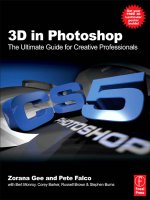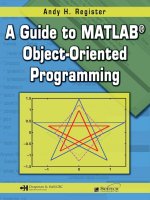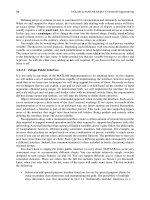The Hands-on Guide for Science Communicators - L. Christensen (Springer 2007) Episode 8 pps
Bạn đang xem bản rút gọn của tài liệu. Xem và tải ngay bản đầy đủ của tài liệu tại đây (884.55 KB, 20 trang )
137
VIDEO PRODUCTION
Figure 57: To the left a
visual analogy for the
workings of a precessing
garden-sprinkler
“nozzle”mechanism,
embedded in the planetary
nebula Henize 3-1475. To
the right, the supernova
explosion that created the
Crab Nebula.
Figure 58: A 2D animation
can look almost as good as
a real 3D animation: A black
hole “eating”material from
its surroundings.
138
THE HANDS-ON GUIDE FOR SCIENCE COMMUNICATORS
15.4.3 Postproduction
Postprodu ction is the phase of a project spent editing the footage and
compositing the footage into the fi nished video. Postproduction con-
sists of:
video editing;
compositing and other video effects;
audio editing;
adding audio effects.
Video editing
The video editing process consists roughly of the following steps:
Organising footage: Most editing software, like Adobe® Pre-
miere®, has an a rchive that gives an overview of the clips in your
project. Most software works with these archives on a project
•
•
•
•
•
Figure 59: Outdoor shooting
scene for the project
described in section 15.9
below.
Bob Fosbury (ESA)
139
by project basis, meaning that it is diffi cult to get a complete
overview of all of the footage you have in your video archive.
This is partly due to the fact that video clips are rather large and
were, in the past, not meant to be permanently online.
previewing clips;
trimming clips to remove unwanted parts;
adding clips to timeline;
adding audio;
adjusting;
colour-correcting;
making transitions;
adding supers and titles.
Here we have dealt exclusively with non-linear video editing as op posed
to (old-fashioned) linear editing from tape to tape. Rough edi ting is
something everyone can do. Artistic editing may not be achie vable by
most, but on the other hand we are in the business of science commu-
nication and not producing Hollywood blockbusters like Blade Runner,
so we can make do with less.
What matters is the right mix of visuals and speak and the right speed
of cuts and dissolves to create a balanced whole. Try to avoid fancy ef-
fects if they are not necessary for the story.
Compositing
Compositin g means combining different digital clips, for instance by
superimposing layers on top of each other to create scenes that could
not be created in one piece (or were not economically feasible). There
are four main methods of compositing:
Reducing the opacity of a top l ayer to allow another layer to
show through (like a “sandwich” of two pieces of slide fi lm).
•
•
•
•
•
•
•
•
•
Figure 60: Video editing in
Adobe® Premiere® from
Adobe’s Video Collection.
VIDEO PRODUCTION
Adobe® Premiere®
140
THE HANDS-ON GUIDE FOR SCIENCE COMMUNICATORS
Using a clip’s alpha channel to “cut” p art of a clip out, for instance
when superimposing supers or titles onto other footage.
Using a matte to let oth er clips show through.
Using bluescreen effects, also known as keying, to “cut” out an
element recorded on real footage.
The combination of animations and real footage using bluescreening
in composi ting is an exciting possibility that gives a whole palette of
different possibilities for human interaction with scientifi c phenomena
that are normally out of reach — from quarks to colliding galaxies. The
technical setup is slightly more complicated and requires a studio with
a bluescreen. This is still far from rocket science and does not have to
incur unrealistic costs. The only function of the bluescreen is to create
a background surface that is “a uniformly monochromatic blank” (most
often blue or green) that can be deleted digitally from the footage later
on using video editing software such as Adobe® Premiere®. Make sure
the subject in the foreground does not wear any clothes that are the
same colour as the screen.
After compositing the fi nished sequence is exported as a fi le in the
format that is needed in the distribution link. Read more about com-
positing in Brinkmann (1999).
15.5 DISTRIBUTION OF VIDEO MATERIAL
15.5.1 Video distribution methods
There different ways of distributing video. Some are, in order of ef fec -
tiveness:
via satellite uplink;
•
•
•
•
Figure 61: The author (left)
directing Bob Fosbury (right)
for a scene fi lmed with
a small bluescreen setup
for the project described
in section 15.9 below. The
bluescreen can also be green
as long as its colour does not
appear anywhere else in the
fi nal product.
Bob Fosbury (ESA)
141
via web (large fi les with broadcast quality video);
postal shipping of Betacam tapes.
Help from external companies, such as MediaLink
45
, is recommended for
the uplink via satellite. Companies like this one may also help in other
stages of a video production, such as tracking (see below).
Distribution via web takes some know-how about the right video for-
mats, and also — since the individual clips can easily be a few hundred
megabytes — some investments in hardware: storage space and In-
ternet bandwidth.
Shipping via postal mail is too slow and is not recommended for news-
oriented products like VNRs.
15.5.2 VNR Media Advisory
In addition to the actual uplink, a media advisory ( media alert) should
be issued to warn broadcasters about the time and technical details
of your distribution.
15.5.3 VNR Evaluation
Since VNRs are costly productions, it may be worth investing in some
resources that track the use of your material (impact statistics or usage
monitoring). In order to track the VNR an invisible code is placed on it,
so that when the footage is used, the station, airtime, and story length
can be determined.
Some methods for tracking are:
NewsIQ;
45
•
•
•
VIDEO PRODUCTION
Figure 62: The result of the
bluescreen shooting with
the set-up in fi gure 61. Note
the colour-correction of
the real footage. This is the
outcome of a composition
of real footage with 3D
animation where the Bob
Fosbury is placed in an
interesting virtual studio
environment.
142
THE HANDS-ON GUIDE FOR SCIENCE COMMUNICATORS
Teletrax;
Sigma;
Vericheck.
15.6 TECHNICAL SPECIFICATIONS FOR DIGITAL VIDEO MATERIAL
An in-depth discussion of the production of video material requires
much technical detail, so only some of the most important topics are
treated here. For more information, Adobe’s Digital Video Technical
Guides
46
is to be recommended.
15.6.1 Video tape media
The standard used today to exchange video footage with television
broadcasters is Betacam SP tapes. While many do use the more expen-
sive and lossless Digital Betacam, SP is still the most widely acceptable
tape format. For consumers, the DVD format has now superseded VHS
tapes almost completely and is the most used consumer video format.
The semi-professional Super-VHS (S-VHS) is still used occasionally. Re-
cently digital tape formats such as Digital Video (DV), miniDV (for con-
sumers), DVCAM and DVCPRO have become very popular.
15.6.2 Frame Sizes
Different parts of the world use different sizes of frames for broadcast
videos, so this is an area that may take a little investment of time and
effort to get right. The standard formats are:
NTSC: Typically digital NTSC frames are 720 x 486 pixels (with a
0.9 pixel aspect ratio, also known as D1). The frame rate is 29.97
frames/second. NTSC is interlaced with two fi elds displayed per
frame (roughly one fi eld per cycle of the alternating current
which is 60 cycles per second). NTSC is used in the United States,
Canada, Japan and some parts of South America.
PAL: Typically digital PAL frames are 720 x 576 pixels. The frame
rate is 25 frames/second. PAL is interlaced with two fi elds dis-
played per frame (one fi eld per cycle of the alternating current
which is 50 cycles per second). PAL is used in Europe, Australia,
and large parts of Asia and Africa.
SECAM: Typically digital SECAM frames are 720 x 576 pixels. The
frame rate is 25 frames/second. SECAM is interlaced with two
fi elds displayed per frame (one fi eld per cycle of the alternating
current which is 50 cycles per second). SECAM is used in France,
Russia and parts of the Middle East.
The NTSC format is somewhat smaller and gives lower quality per frame
than PAL and SECAM, but there are more frames/second, in principle
giving less “ fl icker”. Flicker is more visible on modern digital televisions
as the picture elements (“pixels”) on older (Cathode Ray Tube) televi-
sions have a certain afterglow time making fl icker less pronounced.
46 />•
•
•
•
•
•
143
15.6.3 Data volume
Since the frames are in true-colour (16 million colours = 3 bytes of in -
formation per pixel), we can calculate the storage space needed for
one frame:
USA: 640 pixels x 480 pixels x 3 bytes/pixel = 921,600 bytes =
~
1 MB/frame =>
~
28 MB/second.
Europe: 720 pixels x 576 pixels x 3 bytes/pixel = 1,244,160 bytes
=
~
1.2 MB/frame =>
~
31 MB/second.
So, for both PAL and NTSC formats the full bandwidth needed to “trans-
port” uncompressed video from apparatus A to apparatus B is roughly
30 megabytes. Only large and costly computer and hard disk systems
can sustain this kind of I/O (input/output) rate (“sustain” here really
means never dropping below this rate and causing frames do drop out).
Although “normal” PC/hard disk systems typically deliver at least 10
MB/second (without RAID), it is diffi cult to achieve the necessary three-
fold increase in sustained rate to show every byte of information in
the video frames. It is possible to do this in practice, but it is virtually
never done. The answer lies in compression of the frames — really
smart compression.
Before discussing compression it is perhaps worthwhile considering
whether real-time playback of broadcast video is actually needed. Some
users may be perfectly happy handling broadcast video in a non-real-
time environment. If the footage is produced completely on a computer
(ie does not need to be digitised from tape) and never needs to be
recorded in real-time on eg a Betacam recorder (but for instance dis-
tributed via the web) it is possible to produce video on slower computer
systems. However it is diffi cult to evaluate the production fully as the
footage can never be displayed without jerking motions, but it can
certainly be considered as a worthy low-budget solution.
15.6.4 Compression
In theory each frame can be compressed, or packed, with the help of
smart algorithms that group the information. This is done in two ways:
without losing information and quality (non-destructive or lossless
compression), or with a certain well-controlled loss of quality (destruc-
tive or lossy compression). The compressed information is later decom-
pressed, or unpacked, to be displayed on the screen.
The amount of disk space saved, the compression ratio, depends on the
content of the footage (what is actually fi lmed) and on how quickly the
content changes. As an example, a few stars on a dark background can
easily compress by a factor of 10 times non-destructively, whereas a
monkey moving in a complex natural background may only compress
by a factor of two or less.
Since a factor of 3 in the input/output rate has to be saved to playback
the footage on normal computers, destructive compression is nearly
always used. Some very clever algorithms have been invented to han-
•
•
VIDEO PRODUCTION
144
THE HANDS-ON GUIDE FOR SCIENCE COMMUNICATORS
dle the compression and decompression called codecs (compressor-
decompressor). When compressing, a codec looks at each frame and
fi nds similarities within the frame (the spatial domain) and also in the
temporal domain by comparing the frame with one or more frames to
store only information that describes the differences between frames.
Sometimes compression is visible to the untrained eye as compression
artefacts (“chunky blocks”) in the picture when there is a lot of (tempo-
ral) action (e.g. a fast explosion). In such cases the “informational differ-
ences” between the frames are large, so to keep the information below
the allowed ceiling of the playing device or the network a higher, and
more destructive, compression is applied in that sequence of the fi lm.
Video codec s have names like motion-jpeg ( MJPEG), MPEG-1, MPEG-2,
H.264/ MPEG-4 etc. Note that some of these formats are mainly for
editing and some mainly for distribution to the end-user.
15.6.5 Technical Specifi cations for VNRs
Typical technical specifi cations for a VNR are:
Colour bars: Start of tape, duration 1 min 30 sec;
Black burst: After colour bars, 30 sec;
A-roll material starts at 10:00:00:00;
Split audio tracks: Natural sound and effect on track 1, speak
on track 2;
No “ supers” (names and titles of people interviewed in or speak-
ing on the video) on top of the A-roll footage. Present the infor-
mation on slates at the start of the VNR instead.
15.7 A TYPICAL SET-UP FOR A SMALL VIDEO EDITING SUITE
A small video-editing set-up typically consists of:
computer (typically a medium to powerful PC);
video board with dedicated processing chips for compressing
and uncompressing video frames in real-time;
1-2 computer monitors;
television monitor;
betacam SP tape recorder;
computer loudspeakers;
normal “monitor” loudspeakers attached to the video board;
break-out box with audio and video connection from and to the
different components.
A small full broadcast video-editing system is shown in fi gure 63:
Television monitor showing an accurate representation of the
footage.
Break-out box with audio and video connections to and from
the different components.
Two computer monitors running on the same graphics card in
the PC (the box below the second monitor) .
Microphone for recording of live speak.
S- VHS recorder.
Betacam SP recorder (the television industry’s adopted stan-
dard).
•
•
•
•
•
•
•
•
•
•
•
•
•
1.
2.
3.
4.
5.
6.
145
Loudspeakers.
Computer with a special video board with dedicated process-
ing chips for compressing and uncompressing video frames in
real-time.
Audio mixer.
Jog-shuttle wheel (for remote control of the Betacam during
digitisation of footage).
RAID hard disk array.
Many different types of optional hardware are also available, such as
Jog-shuttle wheels, special keyboards etc.
This type of set-up is typically referred to as a non-linear video editing
system. The term non-linear means that all parts of the video material
can be accessed fully at all times (unlike a video tape which is linear and
the different parts of the tape cannot be accessed at will).
When editing video material, most of the calculation work is taken care
of by a special video board that employs fairly sophisticated technol-
ogy. The calculation power needed by the PC itself is not too demand-
ing, and the main function of the PC is to act as an interface between
the hard disks and the video board. The processing power of the PC
becomes important when doing post-processing work, for example
when combining layers, adding transitions, fi lters or changing colours,
sizes and so on.
At the time of writing (December 2005) the all-inclusive price for a
good complete system with installation and initial training is between
10,000 and 30,000 €.
15.8 PRODUCTION OF MOVIE DVDS
The DVD medium
47
(short for “Digital Versatile Disc” or “Digital Vid-
eo Disc”) for storage and playback of high-quality hour-long movies
emerged in the mid-1990s and has since steadily gained in popularity.
47 Read more in the excellent article at: />7.
8.
9.
10.
11.
VIDEO PRODUCTION
Figure 63: A quick and dirty,
small (but highly capable
and professional) video
editing system. For numbers
please refer to the text.
146
THE HANDS-ON GUIDE FOR SCIENCE COMMUNICATORS
The movie DVD (more correctly known as DVD-video) is an excellent
medium for bringing high-impact science communication directly to
the end-users. It stores large volumes of high-quality fi lm material, but
is very portable and thus easy to distribute (see also section 15.9).
The concept movie DVDs discussed here are different from the data
DVDs used for storing and transporting data (known as DVD-data). The
actual medium may be the same, but the content is “packaged” in a
different way on a movie DVD and involves a full navigation system for
the user. The latter means that when an end-user puts a DVD in a player
(either connected to a TV, or on a computer) “things” happen instantly.
If produced properly, a DVD can hurl the spectator on an interesting
journey into the subterranean lives of earthworms or on a journey to
distant stars and planets almost instantly.
15.8.1 The overall workfl ow of DVD production
As for other video productions, the typical workfl ow for DVD production
has three phases: preproduction, production and postproduction.
Preproduction
1. Technical Preparation: Installing the right technical setup (hard-
ware, software) for production, editing and authoring. This
includes a video board with high signal processing capability for
the real-time editing (see 15.7) and a computer system capable
of sustaining the necessary high rate of I/O. A good and afford-
able solution for the software is, for instance, Adobe’s Video
Collection
48
.
2. Organising thoughts and ideas about the production:
a. fi x content;
b. defi ne aim;
c. set style;
d. allocate budget;
e. produce storyboard (see section 15.4.1);
f. plan menu structure (see section 15.8.4).
Production
3. Production of:
a. footage;
b. music and sound effects;
c. subtitles.
Postproduction
4. Organising all elements.
5. Editing the movie and bonus material (see section 15.4.1).
6. Compositing (see section 15.4.1).
7. Encoding the footage into the fi nal MPEG-2 movies (see section
15.8.3).
8. Authoring (see section 15.8.4):
a. Produce and implement menu structure.
b. Import all elements: MPEG-2 movies, sound and subtitles.
48 />The movie DVD is an
excellent medium for
bringing high-impact
science communication
directly to the end-users.
147
c. Encode sound.
d. Link all elements.
e. Test all links and functions.
f. Export the fi nal DVD.
15.8.2 Different movie DVD formats
The DVD footage format follows the television standards (see 15.6.2
and 15.6.3), so a DVD will be either in PAL, NTSC or SECAM format. There
will also be region codes added to control distribution. This enables
distribution companies to acquire the rights for the distribution of a
commercial (e.g. Hollywood or similar) DVD in a smaller area, so saving
costs. The region codes are:
0. Informal term meaning “playable in all regions”.
1. Bermuda, Canada, United States.
2. Most of Europe, the Middle East, Egypt, Greenland, Japan, Leso-
tho, South Africa, Swaziland.
3. Southeast Asia, Hong Kong, Macau, South Korea, Taiwan.
4. Central America, Oceania, South America, Mexico, Australia.
5. The rest of Africa, Former Soviet Union, the Indian subcontinent,
Mongolia, North Korea, Russia.
6. Mainland China.
7. Reserved for future use.
8. International venues such as aircraft, cruise ships, etc.
15.8.3 Encoding
The DVD standard incorporates a clever compression and decompres-
sion method that uses MPEG-2 encoding (performed offl ine during
pro duction) and decoding (performed during playback without the
user noticing) to “package” the information. The encoding can be done
either in hard- or software with different resulting qualities. The costs
involved span the entire range from 0 € (with freeware), to 25,000 € for
a high quality hardware encoding system. Very good software encoders,
such as the Cinema Craft Encoder (CCE) SP, can be purchased for roughly
1-2000 €. There seems to be a good relation between the price and
quality of encoders, although the incremental quality improvement
per € is much less for the more expensive encoders.
When encoding it is, as usual, a balance between size and quality. There
are currently two typical types of DVDs
49
: DVD-5 which contains up to
4.7 GB and DVD-9 which contains up to 8.5 GB. If less than roughly 150
minutes of movie material is to be packed onto a DVD-9 there should
be few problems in achieving very high quality encoded footage. As
the amount of footage increases, the more diffi cult and sensitive the
encoding becomes and the quality of the encoder becomes much more
important.
15.8.4 DVD authoring
Authoring is the fi nal stage of producing a DVD: implementing a menu
structure and merging all the components into the standard format
49 The current state of technology in December 2005.
VIDEO PRODUCTION
148
THE HANDS-ON GUIDE FOR SCIENCE COMMUNICATORS
readable by DVD players. Software for authoring ranges from Freeware
to Sonic’s Scenarist Professional with a price of roughly 4000 €.
When preparing a DVD keep a clear idea of the functions of the menu
tree of navigational choices presented to users. The individual menu
screens can be produced in Adobe® Photoshop® as layered PSD fi les in
either PAL (720x576 pixels) or NTSC format (720x480 pixels). Buttons
etc have their own layers.
In authoring software, such as Adobe® Encore® from Adobe’s Video Col-
lection®, the following elements are imported:
menu PSD fi les;
encoded MPEG-2 movies (called Timelines in Encore);
sound fi les (in wave format);
subtitles (as unicoded text fi les, see the example below).
The sound fi les are compressed to AC-3 format . The timelines are then
aligned with the corresponding sound and subtitle tracks. The next step
is to produce the actual navigation by linking all buttons to the actions
they should perform (e.g. play Timeline X with subtitle Y).
Extensive testing should then be carried out, both within the authoring
programme as well as on real burned DVDs in a variety of hard- and
software DVD players.
•
•
•
•
Figure 64: Screenshot from
Cinema Craft Encoder SP.
There are a multitude of
settings and options, but
once a good compromise
between quality and size is
found the settings can be
saved in a preferences fi le
and need not be changed
again.
Cinema Craft Encoder SP
149
Once the DVD is ready for export it can be sent for replication. Until re-
cent ly the export could only be done to DLT tape s (old-fashioned magne-
tic tapes for storage, two tapes for a DVD-9) as the break between the
two DVD-9 layers needed to be recorded in a special way. Replication
companies will now also accept dual layer DVD-9s as masters for the
replication. A typical price for a DVD replication copy is roughly 0.30 €
(depending on the volume as the start-up costs are not included).
15.8.5 The future of DVDs
In the future DVDs will most likely have larger storage capability, higher
quality and new smart compression methods. High-Defi nition DVD
formats (HD DVD and Blu-Ray ) with up to 1920 x 1080 pixels interlaced
(1080i), or 1280 x 720 pixels progressive (720p, non-interlaced), should
VIDEO PRODUCTION
Figure 66: This example
shows a subtitle text fi le
that can be imported
directly into Adobe®
Encore®. This has signifi cant
advantages when dealing
with subtitles in many
different languages.
1 00:00:00:00 00:00:02:12 This film takes you on a
journey…
2 00:00:02:12 00:00:05:00 …a journey through time
and space.
3 00:00:37:03 00:00:41:07 I want to tell you the
story of an instrument that has vastly improved
our view of the skies,
4 00:00:41:07 00:00:43:19 sharpening our perception
of the Universe,
5 00:00:43:19 00:00:49:01 and penetrating ever deep
er toward the furthest edges of space and time
Adobe® Encore®
Figure 65: Screenshot from
Adobe® Encore® for the
project described in section
15.9.
150
THE HANDS-ON GUIDE FOR SCIENCE COMMUNICATORS
be within reach in the near future. For science communicators this will
improve the artistic capabilities, enable more details in the frames (eg,
more text), large projection surfaces and in general improve the “Wow!
factor” signifi cantly.
The actual production of HD formats will naturally be more demand-
ing for the obvious reason that a higher I/O rate is necessary, and also
because data storage needs to be increased by up to a factor of 5. Solu-
tions to these issues are being actively developed by hard- and software
companies looking to exploit the huge commercial potential.
15.9 CASE STUDY: THE ESA HUBBLE 15
TH
ANNIVERSARY DVD
15.9.1 Background
24 April 2005 marked the 15
th
anniversary of the launch of the NASA/
ESA Hubble Space Telescope. As an observatory in space, Hubble is a
major project that has made an enormous impact both in terms of
scientifi c output and in its immediate public appeal (see chapter 20).
The 15th anniversary of Hubble’s launch presented the ideal opportu-
nity for a dramatic and dynamic project
50
to grab the attention of the
public, with a special emphasis on the younger generation, and to fur-
ther the knowledge of science in general and astronomy in particular.
In this project, Hubble is presented as a “science superstar” to make
the possible largest impact and reach as many different target groups
as possible, including that section of the general population whose
interest does not usually include science.
15.9.2 Products
The project consisted of a number of activities, or products. The full-
length documentary movie Hubble — 15 Years of Discovery, issued on
DVD and broadcast on television, was the most important. The movie
covers all aspects of the Hubble Space Telescope project — a journey
through the history, the troubled early life and the ultimate scientif-
ic successes of Hubble. More than 700,000 copies of the DVD have
been distributed, making it possibly the most widely available science
documen tary ever. Dr. Bob Fosbury, a scientist from the European Space
Agency, who has frequently used Hubble f or his own research, presents
the movie. Through the movie Bob Fosbury explains various astronomi-
cal phenomena and describes the workings of a major telescope such as
Hubble. As an active, but approachable scientist himself, he brings an
added depth and insight to the material while simultaneously helping
to demystify the image of scientists.
The other products were events, press meetings, large 3-metre anni-
versary images, exhibitions, talks by scientists, educational material,
a coffee-table book, a movie poster, a movie soundtrack and a plan-
etarium show package for planetarium show production.
50 Read more about the individual activities on the Anniversary webpage:
/>In the future DVDs will
most likely have larger
storage capability, higher
quality and new smart
compression methods.
151
15.9.3 Production of the DVD
Preproduction
In the planning phase budget and manpower were allocated. The level
and scope were discussed, decided on and the research started. Mi-
crosoft Word was used as the scripting tool during the six week script-
writing period. Due to the large size of the production (the movie is 80
minutes long) and the very small team, it was not possible to make a
proper storyboard. However detailed comments about the visual con-
tent were included in the script.
Production
The main part of the footage was produced with Cinema 4D. A n impor-
tant part of the movie consisted of studio bluescreen shots and some
scenes were also shot outdoors with the scientist to add variation. For
the real shots a camera team was hired.
Subtitles in 16 languages were made with Microsoft Word and directly
imported into Adobe® Encore®.
See photos from the actual production in section 15.4.2.
VIDEO PRODUCTION
Figure 67: The Australian
DVD label print. Note
the co-branding with the
appearance of the logo of
the local distributor that
creates a co-ownership and
increases the win-win effect.
152
THE HANDS-ON GUIDE FOR SCIENCE COMMUNICATORS
Postproduction
Adobe® Premiere Pr o® 1.5 was used for the video editing and Adobe®
After Effects® 6. 5 Production Bundle for compositing. Adobe® Pho-
toshop® wa s used to produce menus. Adobe® Encore® 1. 5 was used
for authoring.
15.9.4 An alternative business model
Collaborators and partners from more than 20 EU member states and
third party countries joined in the Hubble anniversary celebration and
collaboration on subtitles etc. This truly unique multinational initia-
tive created a multiple win-win si tuation for everyone involved from
the participants in the production to the national partners an d the
end-users. Eventually a “snowball” effect brought enough interested
distribution partners such as magazines and newspapers into the col-
Figure 68: Scenes from
the Hubble – 15 years of
Discovery DVD.
153
laboration so that the production costs of the physical DVD were mini-
mised to the advantage of all involved. Some of the partners even took
out advertisements in large national newspapers and magazines for
the DVD, thereby promoting Hubble and ESA in a way not otherwise
possible. Only the enormous power of a multinational collaboration
made this project possible.
15.9.5 Results
More than 700,000 copies of the DVD movie were distributed through
more than 80 delivery points all over Europe (magazines, newspapers,
science centres etc). This makes it probably the most widely distrib-
uted science documentary ever. Nearly 30 different DVD packages
were made in different languages and quality to cater to the different
needs of the partners. An estimated 10-20 million viewers or more have
watched the movie through various TV channels. The movie has been
shown at numerous venues such as planetaria, science centres, public
observatories etc. Searching on the title of the DVD movie on Google
gives many thousands hits.
VIDEO PRODUCTION
Figure 69: Cover of the
accompanying Hubble
15
th
Anniversary book
(Christensen & Fosbury,
2006).
154
THE HANDS-ON GUIDE FOR SCIENCE COMMUNICATORS
Figure 70: The Bulgarian
cover of the Hubble – 15
Years of Discovery DVD.
155
16. CRISIS COMMUNICATION
16.1 CRISIS COMMUNICATION IN GENERAL
Crisis communication is a discipline well-known to all companies and
commercial enterprises, but “corporate” crises are something that even
we as science communicators cannot avoid. Here follows a condensed
overview of crisis communication, an d I recommend Ogrizek & Guillery
(1999) and Byrne (2002) if further reading is required.
Although everyone has a clear understanding of the concept of a “cri-
sis”, a formal defi nition is elusive, and a few examples of crises will serve
to illustrate possible scenarios:
An accident hap pens at a production plant and the entire pro-
duction of a product has to be withdrawn. The classic example
is the “Perrier crisis”
51
i n 1990 when 160 million bottles of Perrier
mineral water were withdrawn around the world when minute
traces of benzene were detected in Perrier bottles.
Boycotts: Often caused by moral, political, religious or ecologi-
cal issues. Although boycotts of scientifi c institutions are rarely
seen, one example is the public demonstrations in the last half
of the nineties stemming from the launch and fl y-by of NASA’s
Cassini spa cecraft carrying a plutonium reactor
52
.
Rumours: Uncontrollable unoffi cial “underground” thoughts
and comments shared by large numbers of people in a particu-
lar stratum of society. According to Ogrizek & Guillery (1999) it
is quite common for rumours to be well-founded (contrary to
popular belief).
Financial crises: De fi cits, lack of funding, rumours of poor fi -
nancial health etc.
Major technological accidents. Fo r example, the crash of El Al
cargo fl ight 1862 in Amsterdam, the Netherlands, in 1992, the
loss of a rocket like the Arianespace Ariane 501 exp losion in
1996, the Space Shuttle Challenger and Columbia accidents
in 1986 and 2003 or the oil spill of Exxon Valdez in Prince Wil-
liam Sound in Alaska in 1989. One could also mention the fi re
that destroyed LZ-129 Hindenburg in New Jersey, USA, in 1937,
the sinking Titanic off the coast of New Foundland in 1912, the
vibrations that broke Tacoma Bridge in Washington 1940, the
methyl isocyanate gas leakage in Bhopal, India, or the nuclear
power plant accidents in Three Mile Island, Pennsylvania, 1979,
and Chernobyl Ukraine, 1986.
Natural disasters. An example could be the “Black Saturday”
in 2003 where a bushfi re almost completely burnt down the
Mount Stromlo Observatory in Australia.
Crises usually have some features in common:
Extreme time pressure.
51 />52 />•
•
•
•
•
•
•
CRISIS COMMUNICATION
“Corporate” crises
are something that
even we as science
communicators cannot
avoid.
156
THE HANDS-ON GUIDE FOR SCIENCE COMMUNICATORS
Ot her pressure: Both internally, from management, employ-
ees, colleagues etc, and externally, from the press, shareholders,
public …
Confusion.
Em otions: Severe emotional involvements with the victims of
the crisis or internally in the organisation.
Lack of reliable information: Often due to time restraints, geo-
graphical restraints, the nature of the situation, confusion and
other unpredictable factors, it is hard to fi gure out the basic
questions about the crisis at hand: what, how, where, who, why
and when?
Need for quick management decisions.
Media interest: As Byrne (2002) puts it “you are carrying out
decisions in a gold-fi sh bowl”.
Urgent need of internal and external communication.
Acc ording to Ogrizek & Guillery (1999) crises are more likely to occur
today than in the past due to changes in social values (environment,
sexual harassment are some examples), changes in economic structure
and changes in the extent and speed of media coverage. Crisis com-
munication is therefore becoming increasingly important.
16.2 CRISIS MEASURES
So, w hat can be done to “survive” a crisis successfully? The essential
tool to cope with a crisis situation is communication.
•
•
•
•
•
•
•
Figure 71: A major
technological accident. The
explosion of the Arianespace
Ariane 501 launcher
carrying the European Space
Agency’s Cluster satellites.
ESA/CNES
Crisis communication
is therefore becoming
increasingly important.









